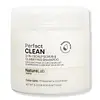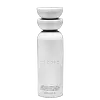NatureLab Tokyo Perfect Clean 2-In-1 Scalp Scrub & Clarifying Shampoo Versus Cécred Clarifying Shampoo & Scalp Scrub
What's inside
What's inside
 Key Ingredients
Key Ingredients

 Benefits
Benefits

 Concerns
Concerns

 Ingredients Side-by-side
Ingredients Side-by-side

Sucrose
HumectantGlycerin
HumectantSodium C14-16 Olefin Sulfonate
CleansingCocamide Mea
EmulsifyingGlycol Distearate
EmollientWater
Skin ConditioningRicinus Communis Seed Oil
MaskingSaccharomyces/Rice Extract Ferment Filtrate
Skin ConditioningButyrospermum Parkii Butter
Skin ConditioningCocos Nucifera Oil
MaskingMelaleuca Alternifolia Leaf Oil
AntioxidantVitis Vinifera Fruit Extract
Skin ConditioningArgania Spinosa Callus Culture Extract
Skin ConditioningMalus Domestica Fruit Cell Culture Extract
Skin ConditioningGlutamic Acid
HumectantSodium PCA
HumectantHydrolyzed Coix Lacryma-Jobi Ma-Yuen Seed
HumectantPlatinum Powder
AbrasiveTrigonella Foenum-Graecum Hydroxypropyltrimonium Chloride
Skin ConditioningLocust Bean Hydroxypropyltrimonium Chloride
Skin ConditioningSodium Hyaluronate
HumectantHydroxypropyltrimonium Hyaluronate
Prunus Domestica Seed Extract
EmollientArgania Spinosa Kernel Oil
EmollientLupinus Albus Seed Oil
Skin ConditioningMangifera Indica Seed Oil
EmollientTheobroma Grandiflorum Seed Butter
Skin ConditioningAdansonia Digitata Seed Oil
EmollientCarapa Guaianensis Seed Oil
Skin ConditioningSclerocarya Birrea Seed Oil
HumectantArgan Oil Polyglyceryl-6 Esters
EmollientSodium Glycinate
Skin ConditioningPropanediol
SolventCocamidopropyl Betaine
CleansingButylene Glycol
HumectantGuar Hydroxypropyltrimonium Chloride
Skin ConditioningIsomalt
HumectantXanthan Gum
EmulsifyingPolysorbate 80
EmulsifyingCitric Acid
BufferingSodium Citrate
BufferingTrisodium Phosphate
BufferingSodium Chloride
MaskingLecithin
EmollientBHT
AntioxidantSodium Gluconate
Skin ConditioningPhenoxyethanol
PreservativeSodium Benzoate
MaskingParfum
MaskingLinalool
PerfumingSucrose, Glycerin, Sodium C14-16 Olefin Sulfonate, Cocamide Mea, Glycol Distearate, Water, Ricinus Communis Seed Oil, Saccharomyces/Rice Extract Ferment Filtrate, Butyrospermum Parkii Butter, Cocos Nucifera Oil, Melaleuca Alternifolia Leaf Oil, Vitis Vinifera Fruit Extract, Argania Spinosa Callus Culture Extract, Malus Domestica Fruit Cell Culture Extract, Glutamic Acid, Sodium PCA, Hydrolyzed Coix Lacryma-Jobi Ma-Yuen Seed, Platinum Powder, Trigonella Foenum-Graecum Hydroxypropyltrimonium Chloride, Locust Bean Hydroxypropyltrimonium Chloride, Sodium Hyaluronate, Hydroxypropyltrimonium Hyaluronate, Prunus Domestica Seed Extract, Argania Spinosa Kernel Oil, Lupinus Albus Seed Oil, Mangifera Indica Seed Oil, Theobroma Grandiflorum Seed Butter, Adansonia Digitata Seed Oil, Carapa Guaianensis Seed Oil, Sclerocarya Birrea Seed Oil, Argan Oil Polyglyceryl-6 Esters, Sodium Glycinate, Propanediol, Cocamidopropyl Betaine, Butylene Glycol, Guar Hydroxypropyltrimonium Chloride, Isomalt, Xanthan Gum, Polysorbate 80, Citric Acid, Sodium Citrate, Trisodium Phosphate, Sodium Chloride, Lecithin, BHT, Sodium Gluconate, Phenoxyethanol, Sodium Benzoate, Parfum, Linalool
Water
Skin ConditioningSodium C14-16 Olefin Sulfonate
CleansingMicrocrystalline Cellulose
AbsorbentCocamidopropyl Hydroxysultaine
CleansingSodium Cocoyl Isethionate
CleansingAcrylates Copolymer
Glycerin
HumectantLactobacillus/Salix Purpurea Bark Ferment Extract
AntiseborrhoeicMelaleuca Alternifolia Leaf Oil
AntioxidantOlea Europaea Fruit Oil
MaskingMentha Piperita Oil
MaskingNiacinamide
SmoothingSodium Gluconate
Skin ConditioningLactobacillus
Skin ConditioningCitrus Limon Peel Oil
MaskingRosmarinus Officinalis Leaf Oil
MaskingMontmorillonite
AbsorbentMenthoxypropanediol
MaskingGlycol Distearate
EmollientPolyquaternium-7
Citric Acid
BufferingHydroxyacetophenone
AntioxidantSodium Hydroxide
BufferingEthylhexylglycerin
Skin ConditioningPotassium Sorbate
PreservativePhenoxyethanol
PreservativeTocopherol
AntioxidantLactic Acid
BufferingSodium Benzoate
MaskingTetrasodium EDTA
Limonene
PerfumingWater, Sodium C14-16 Olefin Sulfonate, Microcrystalline Cellulose, Cocamidopropyl Hydroxysultaine, Sodium Cocoyl Isethionate, Acrylates Copolymer, Glycerin, Lactobacillus/Salix Purpurea Bark Ferment Extract, Melaleuca Alternifolia Leaf Oil, Olea Europaea Fruit Oil, Mentha Piperita Oil, Niacinamide, Sodium Gluconate, Lactobacillus, Citrus Limon Peel Oil, Rosmarinus Officinalis Leaf Oil, Montmorillonite, Menthoxypropanediol, Glycol Distearate, Polyquaternium-7, Citric Acid, Hydroxyacetophenone, Sodium Hydroxide, Ethylhexylglycerin, Potassium Sorbate, Phenoxyethanol, Tocopherol, Lactic Acid, Sodium Benzoate, Tetrasodium EDTA, Limonene
Alternatives
Ingredients Explained
These ingredients are found in both products.
Ingredients higher up in an ingredient list are typically present in a larger amount.
Citric Acid is an alpha hydroxy acid (AHA) naturally found in citrus fruits like oranges, lemons, and limes.
Like other AHAs, citric acid can exfoliate skin by breaking down the bonds that hold dead skin cells together. This helps reveal smoother and brighter skin underneath.
However, this exfoliating effect only happens at high concentrations (20%) which can be hard to find in cosmetic products.
Due to this, citric acid is usually included in small amounts as a pH adjuster. This helps keep products slightly more acidic and compatible with skin's natural pH.
In skincare formulas, citric acid can:
While it can provide some skin benefits, research shows lactic acid and glycolic acid are generally more effective and less irritating exfoliants.
Most citric acid used in skincare today is made by fermenting sugars (usually from molasses). This synthetic version is identical to the natural citrus form but easier to stabilize and use in formulations.
Read more about some other popular AHA's here:
Learn more about Citric AcidGlycerin is already naturally found in your skin. It helps moisturize and protect your skin.
A study from 2016 found glycerin to be more effective as a humectant than AHAs and hyaluronic acid.
As a humectant, it helps the skin stay hydrated by pulling moisture to your skin. The low molecular weight of glycerin allows it to pull moisture into the deeper layers of your skin.
Hydrated skin improves your skin barrier; Your skin barrier helps protect against irritants and bacteria.
Glycerin has also been found to have antimicrobial and antiviral properties. Due to these properties, glycerin is often used in wound and burn treatments.
In cosmetics, glycerin is usually derived from plants such as soybean or palm. However, it can also be sourced from animals, such as tallow or animal fat.
This ingredient is organic, colorless, odorless, and non-toxic.
Glycerin is the name for this ingredient in American English. British English uses Glycerol/Glycerine.
Learn more about GlycerinGlycol Distearate serves as a pearlizing or opacifying agent in cosmetic products.
It's often included in cleansers and haircare products to give them a lustrous or shimmering appearance.
It is derived from stearic acid, a natural fatty acid commonly found in vegetable oils and animal fats.
Glycol Distearate isn't fungal acne safe.
Learn more about Glycol DistearateThis tea tree oil comes from the leaves of the Tea Tree plant. Tea tree oil has antioxidant, anti-inflammatory, and antimicrobial properties.
According to the book Journal of Profiles of Drug Substances, tea tree helps in reducing acne-causing bacteria such as Propionibacterium acnes. This is due to the Terpinen components of tea tree oil.
Tea tree may cause sensitivity and irritation for some people. This oil naturally contains fragrance such as linalool and limonene.
However, research shows irritation usually occurs when using pure tea tree oil and not in cosmetic products.
Tea tree oil was found to help relieve the symptoms of psoriasis in one study.
Tea tree oil is toxic when ingested. Another study showed it to caused damage to the nervous system of dogs and cats when applied to their skin or given orally.
Learn more about Melaleuca Alternifolia Leaf OilPhenoxyethanol is a preservative that has germicide, antimicrobial, and aromatic properties. Studies show that phenoxyethanol can prevent microbial growth. By itself, it has a scent that is similar to that of a rose.
It's often used in formulations along with Caprylyl Glycol to preserve the shelf life of products.
Sodium Benzoate is a preservative. It's used in both cosmetic and food products to inhibit the growth of mold and bacteria. It is typically produced synthetically.
Both the US FDA and EU Health Committee have approved the use of sodium benzoate. In the US, levels of 0.1% (of the total product) are allowed.
Sodium benzoate works as a preservative by inhibiting the growth of bacteria inside of cells. It prevents the cell from fermenting a type of sugar using an enzyme called phosphofructokinase.
It is the salt of benzoic acid. Foods containing sodium benzoate include soda, salad dressings, condiments, fruit juices, wines, and snack foods.
Studies for using ascorbic acid and sodium benzoate in cosmetics are lacking, especially in skincare routines with multiple steps.
We always recommend speaking with a professional, such as a dermatologist, if you have any concerns.
Learn more about Sodium BenzoateSodium C14-16 Olefin Sulfonate is a cleansing agent made from a mixture of long chain sulfonate salts. It can also help produce foam.
This ingredient may be drying. We recommend speaking with a professional if you have concerns.
This is the synthetic salt of gluconic acid, a form of PHA and mild exfoliant.
It is mainly used to stabilize oil and butter formulations from going bad. Sodium gluconate is a humectant, pH regulator, and chelating agent.
Chelating agents help neutralize unwanted metals from affecting the formulation.
Sodium gluconate is water-soluble.
Learn more about Sodium GluconateWater. It's the most common cosmetic ingredient of all. You'll usually see it at the top of ingredient lists, meaning that it makes up the largest part of the product.
So why is it so popular? Water most often acts as a solvent - this means that it helps dissolve other ingredients into the formulation.
You'll also recognize water as that liquid we all need to stay alive. If you see this, drink a glass of water. Stay hydrated!
Learn more about Water